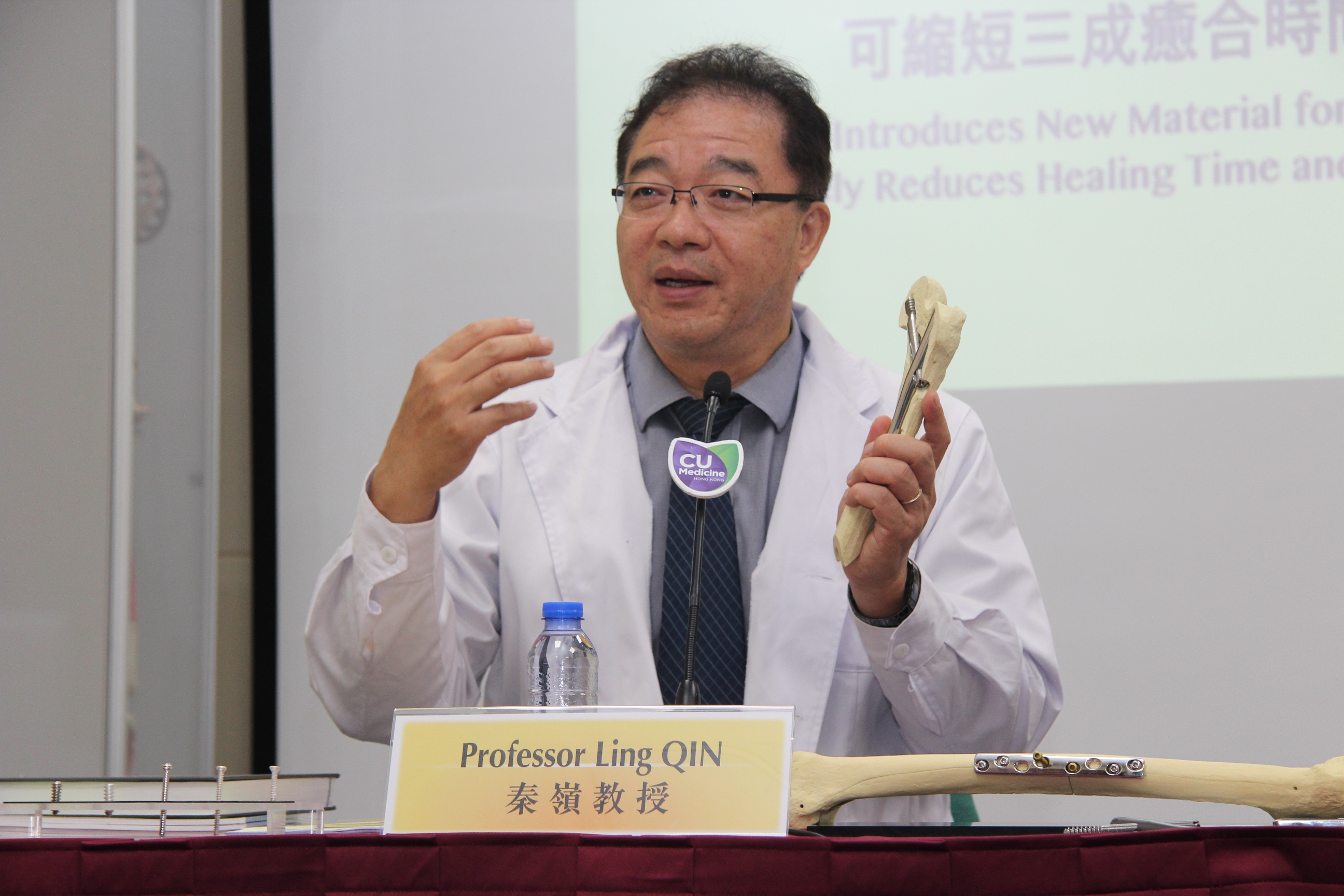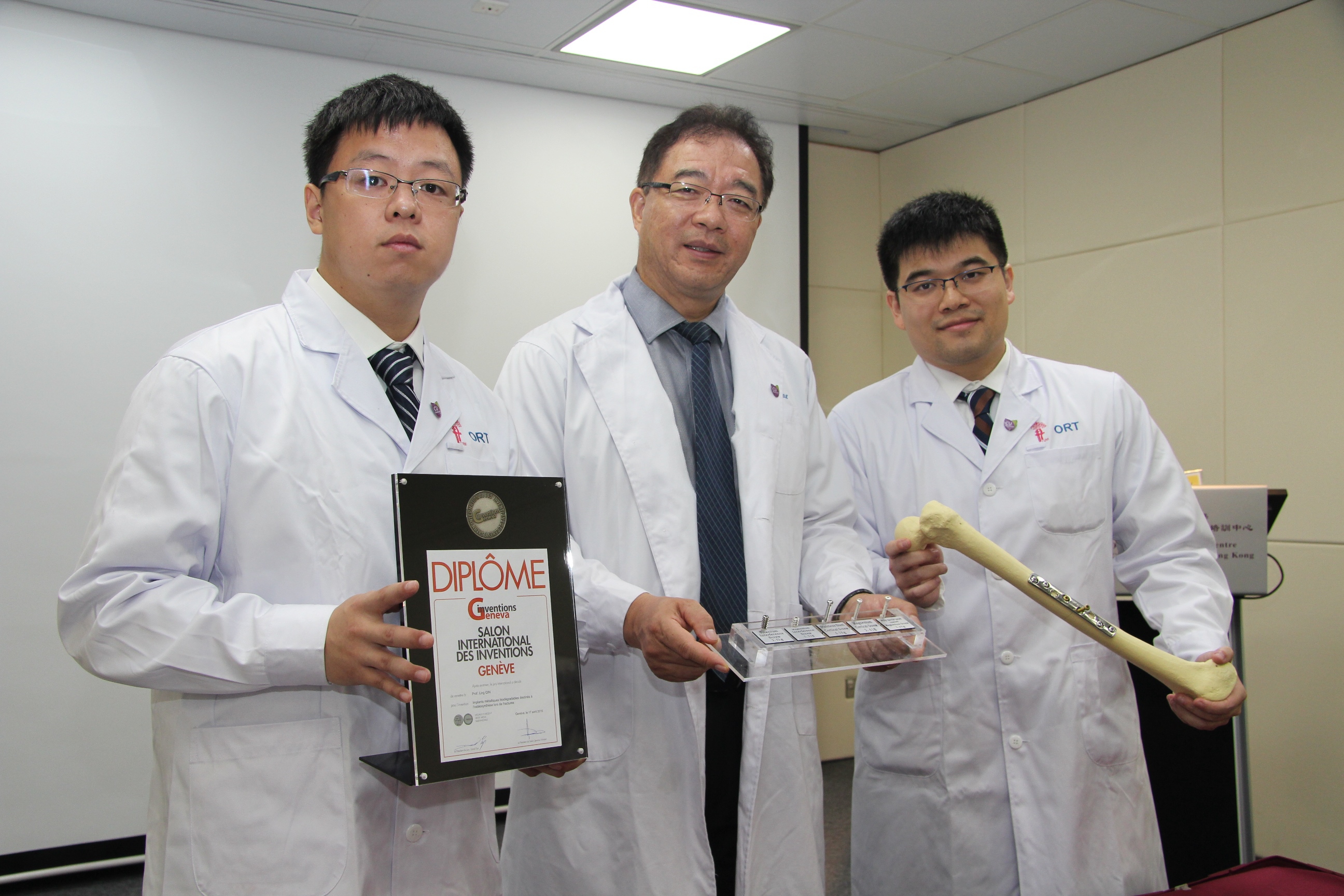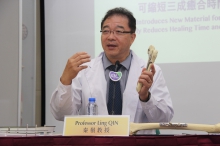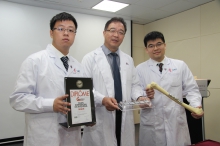CUHK
News Centre
CUHK Introduces New Material for Osteoporosis-related Bone FractureEffectively Reduces Healing Time and Enhances Bone Strength Both by 30%
The Faculty of Medicine at The Chinese University of Hong Kong (CUHK) recently developed an innovative bone implant by combining biodegradable magnesium (Mg) and conventional metals, which can be used for bone fixation in patients with osteoporotic fractures. With positive results in pre-clinical studies, the new material and design have proved not only able to reduce the healing time and enhance the strength of the fractured bone, both by 30%, but also possibly avoid a second fracture. The result of this research has recently been awarded a silver medal in the 43rd International Exhibition of Inventions of Geneva. With the support from the Collaborative Research Fund of the Research Grants Council, the innovation is expected to be applied to osteoporotic-related bone fracture after verification through clinical studies in the future.
Osteoporosis is common around the globe
According to a survey conducted by the Hospital Authority in 2011, there were around 300,000 women and 100,000 men suffering from osteoporosis in Hong Kong. Bone fracture is common among osteoporotic patients due to low bone mineral density and bone loss. A report issued by the International Osteoporosis Foundation in 2013 suggested that an osteoporotic bone fracture occurs every 3 seconds around the world. In China, bone fracture due to osteoporosis reaches 7,000,000 cases every year and one in three women aged 50 and above have suffered from osteoporotic bone fracture. In Hong Kong, there are annually over 15,000 cases of osteoporotic bone fracture.
Osteoporotic bone fracture not only leads to serious complications with high mortality, but also greatly affects patients’ self-care ability. In Hong Kong, more than half of the patients require bone implants for fixation, particularly hip, distal radial and proximal humeral fractures. Taking hip fracture as an example, according to Hospital Authority data in 2013, there are approximately 5,500 elderly people aged 65 or above suffering from osteoporotic hip fracture every year, occupying 17 % of orthopaedic in-patient beds.
Bone implants used for fracture fixation, are conventionally made of stainless steel, titanium (Ti) or titanium alloy. Although such surgery effectively assists in bone healing, those metals are far harder than osteoporotic fracture bone. Some of the patients require a second operation to remove these implants after recovery. Holes left on the bone after implant removal surgery may cause a second fracture due to lower bone density.
New material and design effectively reduces healing time and enhances bone strength
Since 2009, The Department of Orthopaedics and Traumatology at CUHK has been investigating the use of Mg in the development of biodegradable implants fixation, designed for treatment of osteoporotic bone fractures and related orthopedic applications.
The research team revealed that Mg-based bone screws share similar mechanical properties with human bone and are biodegradable in the human body. In addition, Mg’s bone formation function promotes healing at the bone fracture. Pre-clinical studies showed that Mg-based implant can shorten healing time and improve bone strength of the fractured bone, both by 30%. With the application of Mg screws, the number of holes left after implant removal surgery will be reduced, thus a second fracture may be avoided.
The principal investigator, Professor Qin Ling, Professor (non-clinical), Department of Orthopaedics and Traumatology, Faculty of Medicine, CUHK pointed out, ‘Our team discovered that the magnesium ions degraded from the Mg-based orthopedic implant stimulate the release of calcitonin gene-related peptide (CGRP), an osteoanabolic peptide, from the periosteum in long bones. CGRP promotes the osteogenic differentiation of the pluripotent periosteum-derived stem cells (PDSCs) to form new bone and replace the hole left by degraded Mg-based implants. Therefore, Mg-based implant accelerates and enhances bone healing. Besides, magnesium is relatively cheap. The use of Mg-based implants is estimated to decrease material costs by 50%. If the new implants are applied to a clinical setting, the cost of related health care may be significantly reduced in the long run.’
Professor Qin supplemented, ‘The success of the current work signifies a fruitful collaboration between CUHK, mainland research institutes and the industry. We have submitted a patent application for the orthopedic use of Mg-based implant. In addition, we have put together a recommendation for modifying the current cytotoxicity testing standards for biodegradable magnesium-based materials. The recommendation has been recently published in an internationally acclaimed journal and its establishment with ISO/ASTM has also been initiated.’
Professor Qin remarked, ‘We hope to introduce the Mg-based bone implant in the Hong Kong clinical setting through clinical studies and verification in the near future. The research team is conducting more studies to extend its use from fixation of osteoporotic bone fracture to other musculoskeletal diseases, such as anterior cruciate ligament reconstruction of the knee joint seen in many sports injuries. This can benefit more patients worldwide.’
About the Department of Orthopaedics and Traumatology, Faculty of Medicine, CUHK
The research team in the Department of Orthopaedics and Traumatology at CUHK consists of more than 50 basic and clinical researchers and scholars. The research team mainly focuses on investigating local and worldwide musculoskeletal diseases with an aim to promote translational research, knowledge transfer and community service. The musculoskeletal research programmes include 1) Adolescent Idiopathic Scoliosis and Bone Health Research Programme, 2) Computer-Assisted Orthopaedic Surgery and Navigation Surgery Programme, 3) Musculoskeletal Regenerative Medicine and Stem Cell Research Programme, 4) Musculoskeletal Aging Research Programme, 5) Sports Medicine and Regenerative Technology (SMART), and 6) Innovative Orthopaedic Biomaterial and Drug Translational Research Programme.
Prof. Qin Ling points out that, according to pre-clinical studies, the new material not only reduces the healing time and enhances the strength of the fractured bone, both by 30%, but also possibly avoids a second fracture.





